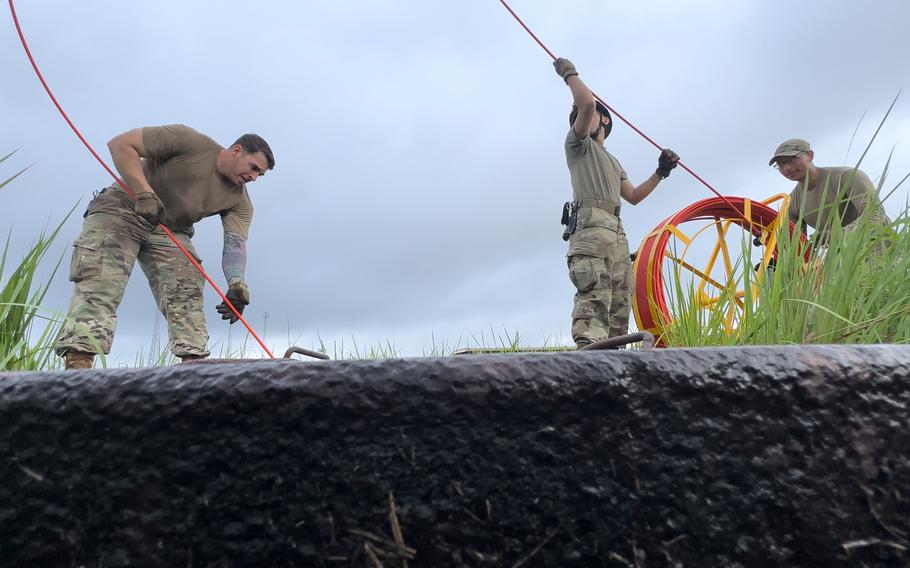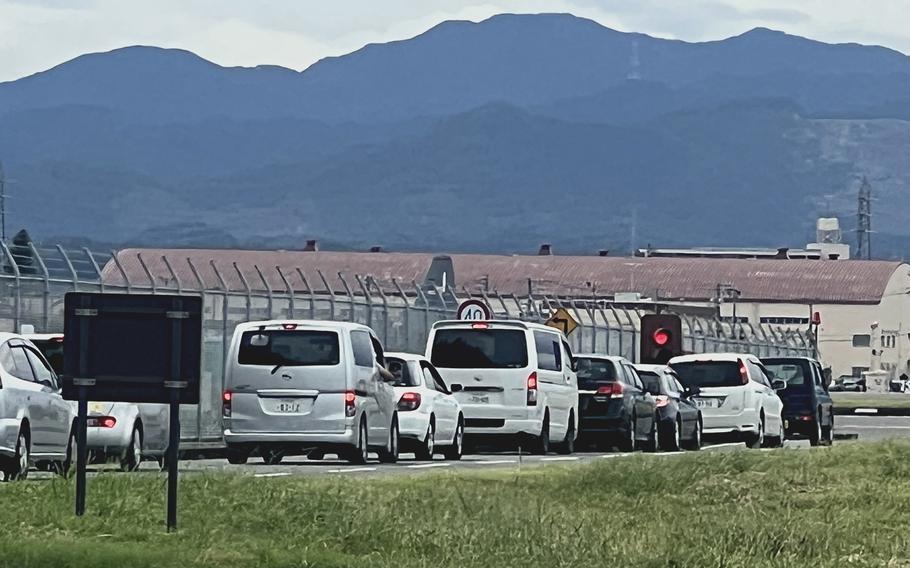
Air Force Staff Sgt. William Johnson, left, and cable antenna technicians Airman 1st Class Gabrielle Oropesa and Senior Airman Carlos Reye, feed a pull string into a duct rodder while replacing underground cable at Yokota Air Base, Japan, on Aug. 23, 2023. (Taylor Slater/U.S. Air Force)
YOKOTA AIR BASE, Japan — When July 4 lightning doused the lights that control vehicular traffic across the south end of the runway at this airlift hub in western Tokyo, the repairs demanded more than a trip to the hardware store.
Yokota Air Base, home of the 374th Airlift Wing and headquarters of 5th Air Force and U.S. Forces Japan, may be the only U.S. military airfield where automobile traffic crosses a portion of an active runway. A set of three traffic lights controls the route across the runway south overrun by indicating yellow to proceed and red to stop, with an accompanying alarm bell, while aircraft approach or depart.
The company that installed the light system in June 1997 no longer exists, Tech Sgt. Johnathan Cox, the noncommissioned officer for inspections and evaluations at the 374th Operation Support Squadron, told Stars and Stripes on Tuesday.
With no information available to repair the system, Cox, of Muskegon, Mich., and his collaborators turned to YokoWerx, a 2-year-old, award-winning innovation cell at Yokota, to work the problem.

Traffic waits at a light to cross the runway south overrun at Yokota Air Base, Japan, on Sept. 21, 2023. (Kelly Agee/Stars and Stripes)
“From my perspective, what I witnessed happening was this organic collaboration that happened super-fast, because everybody is affected by it,” Adrien Sinclair, the YokoWerx chief operating officer, told Stars and Stripes on Tuesday.
The missing lights altered the routine at Yokota, where the day starts for many with a morning commute via two-lane McGuire Avenue from east side homes across the runway overrun to offices and shops on the airfield’s opposite side.
Human “augmentees” sitting inside vehicles substituted for the inoperable lights, stepping into the roadway to stand in furnace-like July and August heat to stop traffic until the runway was clear.
Tech Sgt. Joshua Toellner, a volunteer at YokoWerx, heard that Cox was looking for help repairing the disabled lights.
Toellner on Aug. 15 put Cox in touch with Staff Sgt. William Johnson at the 374thContracting Squadron, and Cox, Toellner and Johnson together designed a fix, Cox said.
YokoWerx on Davis Street on the base provided the space for the three airmen to brainstorm and organize the project.
“YokoWerx can come in and make rapid changes,” Johnson, a Waco, Texas, native told Stars and Stripes on Tuesday. “That’s what innovation is, a rapid immediate kind of change. So, that’s what this cell is empowered to do.”
Using spare parts and a 3D printer at YokoWerx, Cox created circuitry in a box to power the light system. The box was installed in the air traffic control tower, where controllers use it like a switch to control the traffic lights. The system required the 374th Civil Engineering Squadron to lay 3,000 feet of copper cable underground between the tower and the three light installations, Cox said.
The installation took three days, Aug. 25 to 28, and Johnson said he was personally relieved when the lights returned to normal operation after nearly two months. He was one of those people on 12-hour shifts making sure cars safely crossed the overrun.
“I was actually sitting in the truck and that’s what motivated me,” Johnson said. “I finished my shift, and I was like, I’m done. I don’t want to do this. It was very, just, boring.”